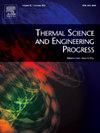利用创新翅片增强相变材料熔化的热性能
IF 5.1
3区 工程技术
Q2 ENERGY & FUELS
引用次数: 0
摘要
加强 PCM 熔化对提高储能系统的热性能至关重要,尤其是在热管理和可再生能源应用中。本研究通过数值方法研究了 PCM 在具有不同翅片几何形状(包括矩形、结构式和树形翅片)的矩形外壳中的熔化情况。对液体分数率、熔化时间和传热速率等关键性能指标进行了分析。使用商业 CFD 软件开发了一个数值模型,并根据实验数据进行了验证,证实了模型的可靠性,支持其在优化热能储存方面的有效性。研究结果表明,添加鳍片可显著提高 PCM 的液体分数并缩短其熔化时间。在测试的设计中,树形翅片的性能最佳,可在 130 分钟内完全熔化,与无翅片外壳相比,熔化时间缩短了 67%。矩形翅片和结构翅片的使用分别使熔化时间缩短了 41% 和 53%。热传导率在开始熔化时最高,随着时间的推移逐渐下降。树形翅片还表现出卓越的能量存储能力,优于结构翅片、矩形翅片和无翅片结构。该研究强调了浮力驱动流在熔化过程中的作用,熔化的 PCM 会上升到外壳顶部。这些结果凸显了新型翅片几何形状(尤其是树形翅片)在优化热能存储系统方面的潜力。本文章由计算机程序翻译,如有差异,请以英文原文为准。
Thermal performance enhancement of phase change material melting using innovative fins
Enhancing PCM melting is crucial for improving thermal performance in energy storage systems, especially for thermal management and renewable energy applications. This study numerically examines PCM melting in a rectangular enclosure with different fin geometries, including rectangular, constructal, and tree-shaped fins. Key performance indicators such as liquid fraction rate, melting time, and heat transfer rate are analyzed. A numerical model was developed using commercial CFD software where validation against experimental data confirmed the model’s reliability, supporting its effectiveness in optimizing thermal energy storage. The findings reveal that the addition of fins significantly enhances the liquid fraction and reduces the melting time of the PCM. Among the tested designs, tree-shaped fins exhibited the best performance, achieving complete melting within 130 min and 67% reduction in melting time compared to the unfinned enclosure. The use of rectangular and constructal fins decreases the melting time by 41%, and 53%, respectively. The heat transfer rate was highest at the onset of melting and gradually declined over time. Tree-shaped fins also demonstrated superior energy storage capabilities, outperforming constructal, rectangular, and unfinned configurations. The study highlights the role of buoyancy-driven flow in the melting process, where the melted PCM rises to the top of the enclosure. These results underscore the potential of novel fin geometries, particularly tree-shaped fins, to optimize thermal energy storage systems.
求助全文
通过发布文献求助,成功后即可免费获取论文全文。
去求助
来源期刊

Thermal Science and Engineering Progress
Chemical Engineering-Fluid Flow and Transfer Processes
CiteScore
7.20
自引率
10.40%
发文量
327
审稿时长
41 days
期刊介绍:
Thermal Science and Engineering Progress (TSEP) publishes original, high-quality research articles that span activities ranging from fundamental scientific research and discussion of the more controversial thermodynamic theories, to developments in thermal engineering that are in many instances examples of the way scientists and engineers are addressing the challenges facing a growing population – smart cities and global warming – maximising thermodynamic efficiencies and minimising all heat losses. It is intended that these will be of current relevance and interest to industry, academia and other practitioners. It is evident that many specialised journals in thermal and, to some extent, in fluid disciplines tend to focus on topics that can be classified as fundamental in nature, or are ‘applied’ and near-market. Thermal Science and Engineering Progress will bridge the gap between these two areas, allowing authors to make an easy choice, should they or a journal editor feel that their papers are ‘out of scope’ when considering other journals. The range of topics covered by Thermal Science and Engineering Progress addresses the rapid rate of development being made in thermal transfer processes as they affect traditional fields, and important growth in the topical research areas of aerospace, thermal biological and medical systems, electronics and nano-technologies, renewable energy systems, food production (including agriculture), and the need to minimise man-made thermal impacts on climate change. Review articles on appropriate topics for TSEP are encouraged, although until TSEP is fully established, these will be limited in number. Before submitting such articles, please contact one of the Editors, or a member of the Editorial Advisory Board with an outline of your proposal and your expertise in the area of your review.
 求助内容:
求助内容: 应助结果提醒方式:
应助结果提醒方式:


